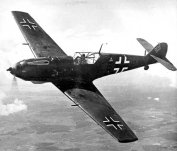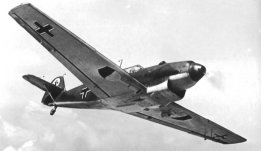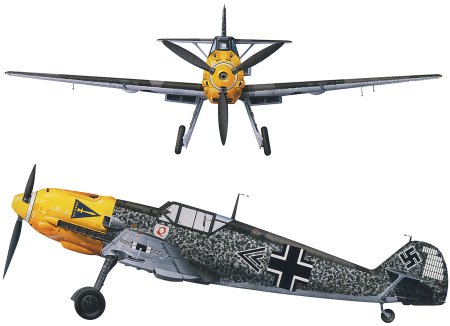
Messerschmitt Bf 109
Having seen extensive service during the Spanish Civil War, early-model Bf 109s had given way to the Bf 109E by the spring of 1940. The Bf 109E series offered superior diving performance and various armament options, including the common layout of two cannon plus two machine-guns. The result was a highly effective fighter, but the operational circumstances of the Battle of Britain meant the odds were stacked heavily against it.
The German fighter pilots knew that their aircraft had an edge in performance over the British Hurricanes and Spitfires and their twin cannon had proved highly effective. But when they were forced to escort the Luftwaffe's bombers further inland, they began to lose their initial advantage.
As long as they were allowed to cross the Channel at altitudes of around 9000 m (29,000 ft) and engage the British fighters in open combat, the 'Emils' more than held their own. Tied though, they lost their independence and before the introduction of the drop tank equipped Bf 109E-7, they could spend no more than 30 minutes over England.
Their pilots faced other disadvantages. British radar could detect the approaching formations, giving the RAF's fighters a tactical advantage. All missions involved long overwater flights and the strain on the Luftwaffe fighter force proved too much. In September the Luftwaffe switched its efforts to night raids on London.
 |
 |
 |
| The yellow nose colours which were used in the initial stages of the battle as a recognition feature. |
Several Bf 109Es fell into Allied hands before, during and after the Battle of Britain. This machine was tested by American analysts. |
By 24 September 1940 the rudder of Adolf Galland's aircraft had 40 kill markings applied. |
|
Messerschmitt Bf 109 (Technical Specification) |
| Role |
Single-seat fighter |
| Manufacturer |
Messerschmitt |
| Maximum Speed |
560 kmh (347 mph) |
| Maximum Range |
660 km (410 miles) |
| Ceiling |
10,500 meters (34,400 feet) |
Weight
Empty
Maximum Takeoff |
1,900 kg (4,180 lbs)
2,665 kg (5,863 lbs) |
Dimensions
Wingspan
Length
Height
Wing Area |
9.87 meters (32 ft 4 in)
8.64 meters (28 ft 4 in)
2.50 meters (8 ft 3 in)
16.40 square meters (176 sq ft) |
| Engines |
One Daimler-Benz DB 601A liquid-cooled inverted V-12 engine which provides 876-kW (1,175-hp) |
| Armament |
One engine mounted 20 mm (0.79 in) MG FF cannon
Four 7.9 mm (0.31 in) MG 17 machine-guns |
Photo Gallery
Click here to submit your photo
| Have A Passion For Aircraft? |
Subscribe to our 14 series FREE newsletter
delivered weekly on World War 2 Aircraft factfile... |
| NB:- We hate spam as much as you do, so your email address will NEVER be shared with or sold to anyone else. That's a Guarantee. |
|
|








